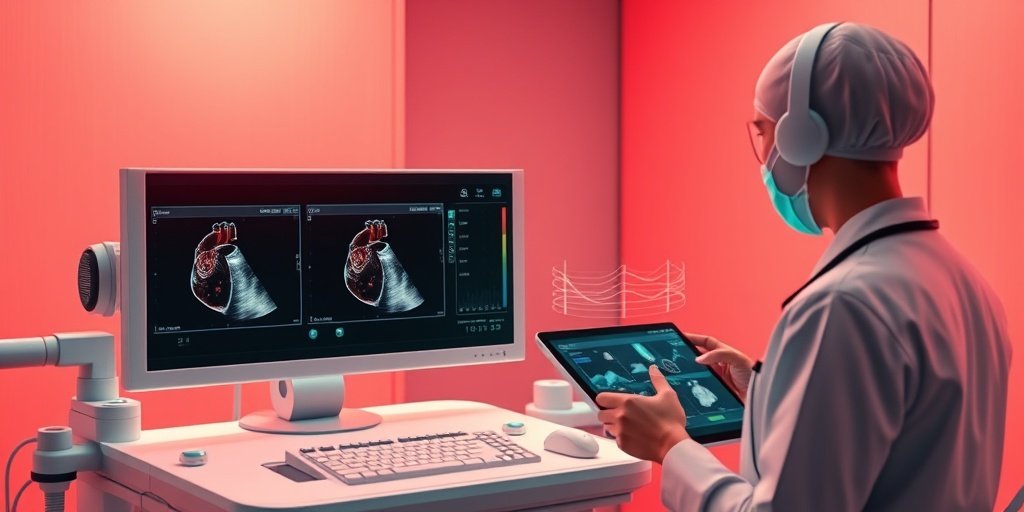⚡ Quick Summary
A recent study introduced DCFFNet, a novel dual-channel cross-feature fusion neural network designed to evaluate the degree of aortic valve calcification using echocardiographic images. This innovative approach achieved impressive metrics, including an accuracy of 96.79% and a precision of 98.59%, highlighting its potential as a reliable diagnostic tool.
🔍 Key Details
- 📊 Dataset: 420 volunteers, 1092 echocardiographic samples
- 🧩 Features used: End-systolic and end-diastolic ultrasound images
- ⚙️ Technology: Dual-channel cross-feature fusion neural network
- 🏆 Performance: Accuracy 96.79%, Precision 98.59%, F1 Score 97.97%, Recall 97.22%
🔑 Key Takeaways
- 💡 DCFFNet represents a significant advancement in evaluating aortic valve calcification.
- 🩺 Echocardiography is positioned as a promising alternative for routine analysis and screening.
- 🔍 The dual-channel input maximizes information retention from both phases of the cardiac cycle.
- ⚙️ A unified preprocessing algorithm was developed to address ultrasound image noise.
- 📈 High performance metrics indicate the model’s reliability in clinical settings.
- 🌍 The study involved a diverse group of volunteers classified by computed tomography scan calcification scores.
- 🤖 AI-assisted diagnosis could enhance the accuracy of aortic valve disease evaluations.

📚 Background
Aortic valve calcification is a prevalent condition that often leads to stenosis, significantly impacting patient health. Traditional echocardiography, while widely used, has struggled with accurately assessing the degree of calcification. The development of advanced machine learning techniques, such as the DCFFNet, aims to bridge this gap, providing healthcare professionals with more reliable diagnostic tools.
🗒️ Study
The study involved a comprehensive analysis of echocardiographic images from 420 volunteers, categorized into healthy, nonsevere, and severe calcification groups based on computed tomography scores. The researchers designed the DCFFNet to utilize both end-systolic and end-diastolic images, enhancing the model’s ability to extract critical features from the cardiac cycle.
📈 Results
The DCFFNet demonstrated remarkable performance, achieving an accuracy of 96.79%, precision of 98.59%, F1 score of 97.97%, and recall of 97.22%. These results underscore the model’s effectiveness in accurately classifying the degree of aortic valve calcification, making it a valuable tool for clinicians.
🌍 Impact and Implications
The introduction of DCFFNet could significantly transform the landscape of aortic valve disease diagnostics. By enhancing the precision of echocardiographic evaluations, this technology may lead to earlier detection and better management of calcification-related conditions, ultimately improving patient outcomes and quality of care in cardiology.
🔮 Conclusion
The development of the DCFFNet highlights the potential of artificial intelligence in revolutionizing the assessment of aortic valve calcification. With its high accuracy and precision, this model paves the way for more reliable echocardiographic evaluations, promising a brighter future for patients with aortic valve diseases. Continued research and implementation of such technologies are essential for advancing healthcare practices.
💬 Your comments
What are your thoughts on the impact of AI in cardiology diagnostics? We would love to hear your insights! 💬 Share your comments below or connect with us on social media:
DCFFNet: A New Dual-channel Cross-Feature Fusion Net for Evaluating the Degree of Aortic Valve Calcification Based on Echocardiographic Images.
Abstract
Aortic valve calcification is a common cause of stenosis. Echocardiography, although being the preferred and most prevailing diagnostic technique for aortic valve diseases, lacks effective methods for accurately rating the degree of aortic valve calcification. In this study, a dual-channel cross-feature fusion neural network was developed to classify the degree of aortic valve calcification. The dual-channel input is designed to accept both end-systolic and end-diastolic ultrasound images of a patient, thereby maximizing the retention of vital information from both phases of the cardiac cycle. Feature extraction scale was also dynamically adjusted using the squeeze-and-excitation module. To better integrate multilevel and multiscale information, a dual-branch feature fusion module with cross-feature fusion and multiscale feature extraction was designed, thereby enabling the network to merge global and local feature information. Moreover, to address the specific noise characteristics of ultrasound images and low valve occupancy in the aortic short-axis view, a unified preprocessing algorithm was developed. A total of 420 volunteers were internally selected and classified based on computed tomography scan calcification scores (140 cases per category: healthy, nonsevere, and severe).Each patient contributed 2-4 cardiac cycles, resulting in a final effective dataset of 1092 samples. The classification model achieved an accuracy, precision, F1 score, and recall of 96.79%, 98.59%, 97.97%, and 97.22%, respectively. The artificial intelligence-assisted diagnosis system proposed in this study exhibits high precision in evaluating the degree of aortic valve calcification, positioning echocardiographic examination as a promising alternative in routine aortic valve calcification analysis and screening.
Author: [‘Wang Z’, ‘Tian G’, ‘Wang Y’, ‘An G’, ‘Liu X’, ‘Gu X’, ‘Cao Y’, ‘Zhang W’, ‘Hao D’, ‘Liu Y’]
Journal: J Imaging Inform Med
Citation: Wang Z, et al. DCFFNet: A New Dual-channel Cross-Feature Fusion Net for Evaluating the Degree of Aortic Valve Calcification Based on Echocardiographic Images. DCFFNet: A New Dual-channel Cross-Feature Fusion Net for Evaluating the Degree of Aortic Valve Calcification Based on Echocardiographic Images. 2025; (unknown volume):(unknown pages). doi: 10.1007/s10278-025-01606-3